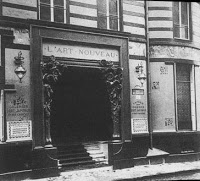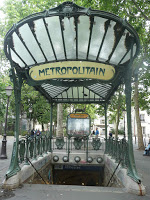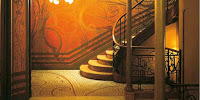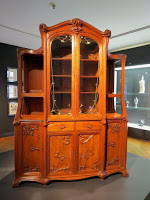Good friends like to tease me about my attention to my special interests. When asked, I’m always quick to note that I have three (in no particular order): my love of elephants, my devotion to opera, and my joy in discovering the subtle—and sometimes not-so-subtle—pleasures of Art Nouveau.
The first comes up pretty often, as demonstrated from time to time in these posts. Opera, too, gets written about frequently here. My third interest, though, hasn’t had much coverage in the past. So far I have written only twice about Art Nouveau, in a description of the style in Brussels when I visited there in 2010 (Brussels Art Nouveau, February 24, 2010) and a longer, very admiring post from Paris (Ah, Paris: Pierre Cardin’s Art Nouveau Museum at Maxim’s, January 26, 2014). Obviously I have a way to go if I’m going to catch up and give greater attention to Art Nouveau in the future.

As I speak with friends about Art Nouveau, I’m often asked for a definition, and I usually begin by noting that this decorative movement or style seems to have been particularly short-lived. Some say it began about 1889 and for others the beginning period was in the early 1880s. For me, 1895 to 1915 seems to work best, for it was at the end of 1895 that Siegfried Bing opened his Maison de l’Art Nouveau at 22 rue de Provence in Paris. The title soon was conveniently abbreviated in popular conversation to l’art nouveau and with the success of the gallery and with the equal success of the gallery’s displays at the 1900 Exposition Universelle, the phrase became attached to a type of decorative and design style that was to become increasingly popular.
The term (and the style) came about in reaction to what had preceded it. After all, there can’t be a “new” art/architecture without there having been an “old” one before it. Until the advent of Art Nouveau, almost all styles of architecture and decorative arts drew heavily on historical precedent. The 19th century was rife with revivals: Gothic, Romanesque, Greek, Renaissance (adapted with Beaux Arts) and more. Connected to this attraction to earlier forms and contributing to the need for and development of a new direction in art was the fact that the 19th century also saw a huge growth of wealth as a result of the industrial revolution, the expansion of the railroads, and other technological improvements. In most cases, wealth was concentrated in relatively few hands. In the United States, the period went under the name of the Gilded Age. In France it was La Belle Époque (the “beautiful era”), and other countries had their own names for this period. Many of these newly rich (the nouveau-riches) sought extravagant examples of these same revival styles. Others, sometimes but not always younger, sought a style that did not look to the past. They wanted something new. Art Nouveau fit the bill.
Sadly, and despite its earlier success, the popularity of Art Nouveau began to wane as early as the First World War (though certainly examples of fine Art Nouveau came later). And it spread out, turning up almost all over Western Europe (and even in Russia, as I discovered when I was in St. Petersburg a few years ago). Not surprisingly, there were many variations, and these variations were based on many factors, including geography, national interests, styles, and the specific tastes of many of the movement’s patrons.

Paris Metro entrances
designed by Hector Guimard
As Art Nouveau became more recognized, the style was referred to by a wide variety of names. The original designation—l’art nouveau—was generally capitalized when written in English but written in lower case in French. The term began to appear in many forms, reflecting the several languages of its different locations. In France, for example, in addition to the popular term (l’art nouveau) the style was sometimes spoken of with an English phrase, the “modern style,” related to the Arts and Crafts Movement. And in either case, when Art Nouveau was (and is) discussed in Paris the names of architect and designer Hector Guimard and the furniture designer and industrial designer Eugène Gaillard are often heard. Across the Channel, we hear about the Glasgow style and in most cases in the same sentence, the names of Charles Rennie Mackintosh, the Scottish architect and designer and his artist wife Margaret Macdonald, both of whom were noticeably influential to the Art Nouveau movement. Although different from what most of us might think of as Art Nouveau, Mackintosh became one of the most respected of the Art Nouveau specialists (as did—in his own way—Louis Comfort Tiffany, who led this work in America).

Entrance Hall to His Home (Brussels)
In Brussels there’s the style coup de court, reflecting (jokingly I presume) the nickname “whiplash” and associated with architect Victor Horta and the architecture and furniture designs of Henry van de Velde. In a different part of Europe, if you visit Barcelona you’ll hear much discussion about a style that is similar to Art Nouveau. There it is known as Moderisme, reflecting the critical work of architect Antoni Gaudí and others. In Vienna you’ll hear Secessionsstil for the movement, with Otto Wagner’s name prominently associated with it, as well as that of designer Josef Hoffman. Germany has its Jugendstil, and in Italy we hear about Stile floreale or—the one I like—Stile Liberty, after the store in London that for Italians of the late 19th- and early 20th-centuries seemed to evoke what we think of as Art Nouveau. As I say, these are just a few examples but, hopefully, they give us a snapshot of how this style had so much influence in the short time in which it was such an important part of the architecture, art, and design movement.

cabinet displayed at the
Bröhan-Museum, Berlin
As you’ve noticed, I’ve used not only the term “style” to identify Art Nouveau. The term “movement” comes up often when we discuss Art Nouveau, and others speak about the “philosophy” underlying Art Nouveau as a style or movement. This is, I think, because of some of the external forces I mentioned above, the growth of wealth, the desire to move beyond artistic and design attributes of earlier historical times, and—not least of all—perhaps a late 19th century interest for exploring a style to “live with,” to create an environment that was not only pleasing to the people who created it and offered it to the (obviously well-to-do) public, but to the patrons themselves who were willing and even enthusiastic about having this particular style as part of their lives. There are indications that for many who were drawn to Art Nouveau—despite its brief popularity—they wanted to surround themselves with this particular style.
And they—many of them—took the idea of “surrounding themselves” seriously, to such an extent that some critics and scholars in the field came to recognize that with Art Nouveau its creators and patrons saw the movement as an “ideal” or “total” work of art and design (connecting, perhaps, with Wagner’s Gesamtkunstwerk, in which all elements of the art combine to provide a unifying experience, all supporting a single form of expression). That idea might be a little grand but in fact with Art Nouveau the style (as short-lived as it was) became an almost universal way to think about architecture, art, design, furniture, jewelry, household utensils, silver, and a vast array of other art and craft applications. Indeed, the word “universal” is used in a digital exhibition, Art Nouveau: A Universal Style at the Europeana Collections site, a delightful little display that provides considerable pleasure in and of itself. Had those of us who have so much fun with Art Nouveau today lived in the movement’s heyday, we too would have loved surrounding ourselves with Art Nouveau all over the place (or at least visiting places where it was available to be seen, even if we were not in the financial bracket for acquiring it for ourselves.
So with all that background, how do we define Art Nouveau? The best definition, to my way of thinking, comes from looking at examples. As I say, it’s not all the same, but the similarities are there: the focus on nature and natural structures and, in particular, botanical shapes, the curving, almost sensuous lines, and, a special joy to me, the many bold and dynamic color combinations. Like any artistic movement, Art Nouveau did not develop in a vacuum. Indeed, it was in many ways made possible by technological changes in fields as varied as building, printing, furniture production, and more. Thanks to the openness of architects, designers, and artists (especially in reaction to what had come “before”), new opportunities to aesthetic possibilities led to graceful, eye-pleasing forms, demonstrated in what we have in our minds’ eye when we think about Art Nouveau.
Leave a Reply